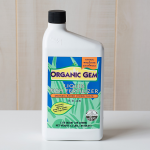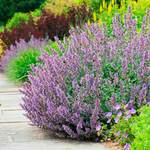Product Details
This Rose and Clematis duo will adorn a fence, trellis, or tuteur with jewel-bright colors all summer long. The Garnets and Gold Rose & Clematis Collection includes 'Golden Showers' is one of a handful of climbing Roses good enough to win a seal of approval from the All-America Rose Selections® and Clematis 'Étoile Violette'. Vigorous 'Golden Showers' produces sprays of fragrant, double flowers that open Daffodil yellow and soften to primrose. Deadheading encourages continued bloom, but we stop removing spent flowers late in the season to allow development of colorful hips to end the gardening year. Its companion, Clematis 'Etoile Violette,' bears deep purple, 3″ blooms in such profusion that they all but obscure the foliage. Peak bloom of 'Etoile Violette' falls in July here, with rebloom into September. Exclusive.
Please note: Each collection includes 1 Clematis and 1 Rose. Our Roses are large, #1 grade plants. Climbing Roses throw long canes that can be trained up posts, arbors, and walls, providing a vertical design element or a stunning backdrop for the mixed border.
Tip: We use Organic Gem® as a foliar feed on Rose bushes in our trial garden and find plants are healthier and perform better throughout the season.
Shipping
HOW PLANTS ARE SHIPPED
The size of the plants we ship has been selected to reduce the shock of transplanting. For some, this means a large, bareroot crown. Others cannot travel bareroot or transplant best if grown in containers. We ship these perennials and annuals in 1 pint pots, except as noted. We must point out that many perennials will not bloom the first year after planting, but will the following year, amply rewarding your patience. We ship bulbs as dormant, bare bulbs, sometimes with some wood shavings or moss. Shrubs, Roses, vines, and other woody plants may be shipped bareroot or in pots. The size of the pot is noted in the quick facts for each item.
WHEN WE SHIP
We ship our bulbs and plants at the right time for planting in your area, except as noted, with orders dispatched on a first-come, first-served basis by climate zone. We also ship a wide range of containers and planters, tools, supplies, fertilizers, garden wear, garden decor items, as well as indoor decorations like wreaths and dried bouquets when available. Estimated dates for shipping are indicated in the green Shipping Details box for each item. Please supply a street address for delivery. Kindly contact us with two weeks notice, if you'll be away at the expected time of delivery.
OUR GUARANTEE
We guarantee to ship plants that are in prime condition for growing. If your order is damaged or fails to meet your expectations, we will cheerfully replace or refund it. Please contact our Customer Service Department at 1-800-503-9624 or email us at [email protected]. Please include your order number or customer number when contacting us.
Reviews
Average Customer Rating:
 (16 Reviews)
Write a Review
(16 Reviews)
Write a Review
Sort by:
Nothing short of amazing 
A viewer from NJ, USA
5 of 5 people found this review helpful. Do you? yes no Certified buyer
Good, but not as pictured 
Minnie from Colbalt, CT
I am sorry you are not pleased with the color of the blooms of the Clematis in this collection and you will be compensated because all of our products are guaranteed for full satisfaction, however, this is how the color is described in the product details for this offering: Clematis 'Etoile Violette,' bears deep purple, 3″ blooms. In addition, White Flower Farm never adjusts the color of photos. The photographers painstakingly do their very best to capture the true color of all blooms. I will be contacting you directly via email regarding compensation.
Sincerely,
Cathy
5 of 5 people found this review helpful. Do you? yes no Certified buyer
First season bloom 
Maudie from Normal, IL
Rose died but Clematis lived on. 
Rob from Bristol, CT
Clematis part of this duo both died. 
Shandy from Petaluma, CA
Growing guide
Plant the Rose first, then site the Clematis. Select a site in full sun, with evenly moist but well-drained soil.
Choosing a site. Roses grow best where they receive at least 6 hours of direct sun per day (more sun means more blooms) and where the soil is well drained. They tolerate a range of soil types (from sand to clay), as long as care is taken to prepare the soil at planting time. Clematis are somewhat less tolerant, and prefer a well-drained soil with a pH close to neutral.
Planting the Rose. Before planting a bareroot Rose, remove and discard the packing material and soak the roots for a few hours (not longer). Then dig a planting hole that allows sufficient room for the depth and spread of the roots. Locate the hole so that the base of the Climbing Rose will be about 1′ from the trellis. Discard about one third of the soil dug from the hole and replace it with at least as much organic matter—such as compost, aged manure, or leafmold—and mix it into the remaining soil. Next, set the plant in the hole so that the bud union (the bulge where the top was grafted onto the rootstock) or the point where the first branch leaves the main stem (on Roses that were not grafted) is 3″ below the surrounding soil in the North, and at the same level or an inch above the soil in mild-winter climates. Then push the mix of soil and organic matter back into the hole, tamping firmly as you go. Water thoroughly. Mound the soil around the canes to a height of 12–15″. This prevents the canes from drying out in the sun and wind. Check the canes every couple of days for new growth, and remove the mounded soil gradually once growth appears.
Planting the Clematis If you want the Clematis to clamber up through the Rose, plant them about a foot apart. Plant the crown of bareroot Clematis more deeply than you would other woody plants: fully 3–4″ below soil level. This will feel wrong, but will produce a stockier plant.
Moisture needs. Newly planted Roses need the equivalent of 1″ of water per week throughout their first growing season. If water doesn't fall from the sky, you must supply it. A generous layer of organic mulch (compost or composted manure is best) helps keep the soil evenly moist. However, be aware that Clematis do NOT benefit from a heavy summer mulching. Clematis grow best when their roots are kept cool; plant annuals or shallow-rooted perennials such as Campanulas at the foot of the vine to shade the root zone. Do not use thick mulches in summer, as they can promote Clematis wilt, a fungal disease that causes all or part of the foliage to wilt, usually in late spring, just as many varieties are beginning to bloom. If your Clematis wilts suddenly, cut the vines back to healthy growth—to the ground if necessary. An otherwise vigorous plant will resprout from below the soil.
Fertilizing. Roses grow more vigorously, bloom more prolifically, and show greater resistance to diseases if fertilized several times during the growing season—in early spring (except the first spring after planting), immediately after the first wave of bloom, and again in early August. (Southern and western gardeners may wish to fertilize more frequently—fertilizing monthly from early spring until June, pausing during the heat of summer, and fertilizing again in August and September to close out the season.) We prefer natural fertilizers such as fish emulsion or seaweed extract, applied in solution, because they release their nutrients more slowly and evenly.
About pests and diseases. The Roses we offer were selected for their vigor and their resistance to pests and diseases. If planted and grown as we suggest, they will be healthy, and healthy plants are much less troubled than plants under stress. Even if a healthy plant does suffer at the hands of a pest or disease, it will likely endure and recover without intervention on the part of the gardener. Some roses are prone to fungus in hot, humid areas. Cleaning up old foliage and cutting back affected canes is important for disease control. Spraying the leaves with Bordeaux mixture, a copper-based fungicide, can help once symptoms appear (follow the manufacturer's instructions).
Pruning. Prune Roses to remove deadwood and to control ungainly growth. Deadwood can be removed at any time. Remove the spent flowers to promote more bloom, cutting the stems back to the second set of 5 leaflets. For the Clematis, early next spring—after the plants have spent a year in the ground—prune the stems of all varieties to the lowest pair of healthy buds. Thereafter prune to control size and shape or to encourage more profuse bloom. 'Etoile Violette' can be cut back to 18″ every spring (or at least every 3–4 years) if desired.
Overwintering. Much has been written about techniques for overwintering Roses. In our experience, the best way to get Roses through winter is to choose plants adapted to your climate zone. That said, if you live near a Rose's cold limit and you garden on an exposed site or in an area where rapid temperature fluctuations are common, you should mound two shovelfuls of composted manure, garden soil, compost, or shredded leaves over the base of the plant in late fall—ideally after the ground freezes. Pull the mounding material away from the stem as new growth emerges in spring. Do not prune Roses or Clematis back in fall; wait until spring to prune branches injured over winter.







